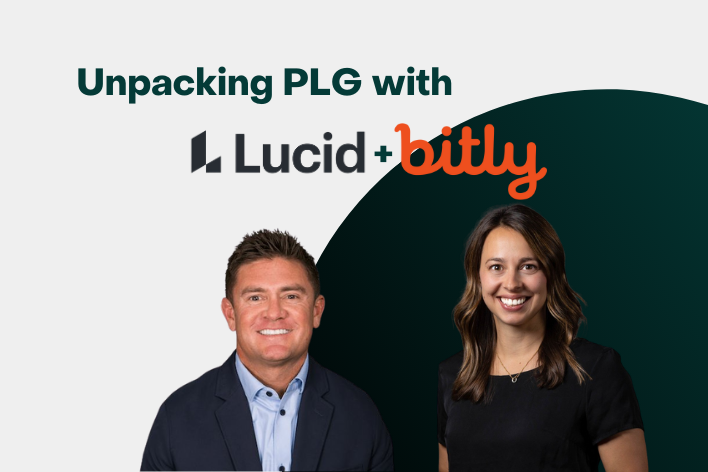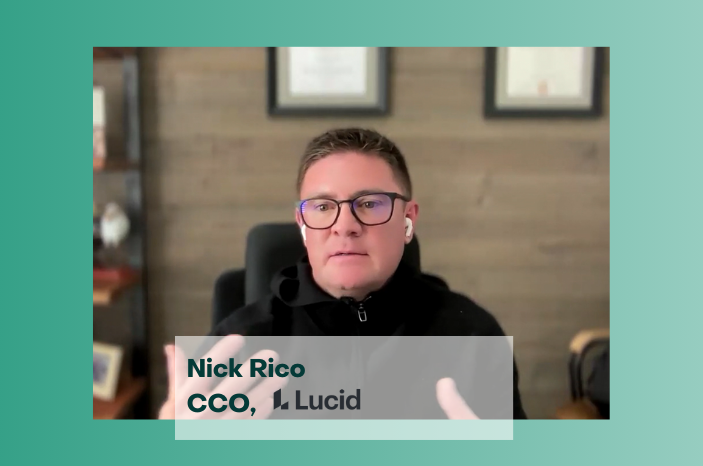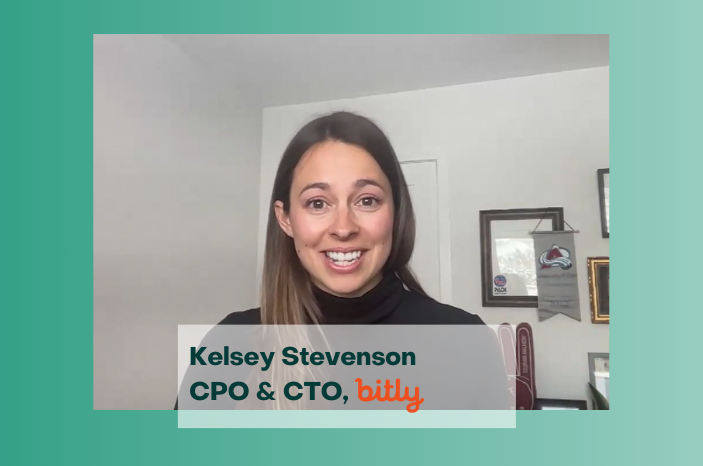perspectives
Unpacking the PLG Motion with Bitly and Lucid Software

Bitly and Lucid Software are very different businesses — one is a connections platform with a ubiquitous link and QR code generator and 4.5 million MUAs, the other a visual collaboration platform with 70 million users in 180 different countries. But both have something that many companies want, and many fewer achieve: a solidly established PLG (Product-Led Growth) motion that has brought them exponential scale.
As part of Spectrum’s virtual workshop series (hosted by CMO Dan Kimball and CTO Sanjay Tiwary), Lucid CCO Nick Rico and Bitly CPO & CTO Kelsey Stevenson recently compared notes on their PLG journeys: wins, learnings, and how’d they advise other companies to get started.
Beyond buzzwords: Making PLG work for your business
“In traditional sales-led companies, the whole goal is to take a targeted buyer, or ICP, from Point A to Point B in a sales cycle,” says Nick. “The PLG motions flip this on its head.”
At Bitly, the team has leveraged their (truly) viral free product to build a user base — and then focused on monetizing those users. “There are so many different flavors of PLG,” says Kelsey, “But at its core, it depends on your ability to activate, engage, and then monetize your customers all from within the product.”
“At Lucid, we empower our users from the outset by giving them the ‘keys’ early on,” says Nick. “New users can effortlessly create an account, quickly learn to navigate the core functionalities of Lucid's products, and start collaborating with their team.”

A seamless onboarding process allows users to experience real, tangible value from our products before ever needing to interact with Lucid’s sales team. It also reduces friction and enhances user satisfaction, fostering a positive initial experience with the platform.
But while this might seem straightforward, the right levers — in your product, in your team, and in your goals — are different at every company.
“When our leadership at Bitly first got excited about PLG and PLS (Product Led Sales), they quickly became internal buzzwords,” says Kelsey. “But you can’t just re-brand your growth or sales strategy. You have to reflect those changes in the product.”
As Lucid's experience has shown, these changes also affect how your team is structured and how well they connect. "To turn this concept into reality," Nick notes, "departments and teams must focus on refining their internal operations and how they collaborate as a company."
The key: If it was easy, everyone would do it. Product-Led Growth generally requires a paradigm shift for your team, and a willingness to re-think team structure, ownership, and goals.
Lucid and Bitly’s PLG journeys: Product, Monetization, and Sales
Nick joined Lucid after nearly a decade at Ancestry.com. "Initially, Lucid operated much like a direct-to-consumer subscription company, with the sales team functioning independently,” Nick reflects. “Today, our main objective is to integrate Lucid seamlessly into the workflows of knowledge workers at large companies. We've made significant strides toward this goal by unifying our efforts and operating as one cohesive go-to-market team."
As for Kelsey, she joined Bitly’s product team in 2019, became CPO in 2022, and added CTO to her role in 2023. In the nearly four years since she joined, Bitly has evolved their pricing model, expanded their product solutions, and used strategic acquisitions to grow their offerings.
While neither of their journeys have always felt linear — and neither consider their journey to be complete — both leaders can now identify areas they’d advise any PLG-curious leader to invest in: product, monetization, and sales.
The foundation: Adopt a “Relentless” focus on your product
First things first: A strong product led growth motion starts with a strong product. Most companies looking to develop their PLG motion have confidence in their product development — the key, for both Kelsey and Nick, is to keep your foot on the gas. That could mean continuously optimizing your user journey, or exploring entirely new capabilities.
“Our focus on the in-product experience is relentless,” says Nick. At Lucid, the Product, Growth, and Marketing teams are all responsible for this focus — whether it’s through onboarding personalization, in-app education, or feature layout. “Every friction point along the customer journey is under scrutiny.”
When Kelsey started at Bitly, the team already had a low-friction way to engage users (and a viral acquisition channel) in their link shortener. In 2022, they acquired a company whose flagship product was a QR code generator — the true Cinderella story of the pandemic — as a new way to bring in and engage users.
Interrogate, refine, and (eventually) line up price and value
“Your product does a lot of the lifting,” says Nick, “but you still need an intentional journey for the user — you have to figure out how to move them up the value chain.”
For Kelsey’s team, this meant — and still means — converting Bitly’s 10 billion monthly clicks and scans into paid users. “Our focus today is on that monetization bucket,” she explains “Bitly has a very, very large free user base — so we’re looking for any growth in conversion among that free to paid audience.”

At its inception, Bitly had only one option for self-service users — a free plan — and only one path to monetization through its sales-assisted, enterprise product. Relying entirely on their sales team to generate revenue, their CAC was high, their free user base was under-leveraged, and the long-term success of the company hung in the balance.
In 2019, they introduced paid self-service plans, allowing them to refine their free-to-paid motion. The team also worked to line up value through pricing and packaging, working to meet customers where they were in their journey. With their new Free plan and pricing page updates, among other incremental tests, they were able to increase conversion by 50%.
Connect product activity to the sales funnel (easier said than done)
“PLG and enterprise selling can and should complement each other,” says Nick. Both Bitly and Lucid looked for ways to mine fit and behavioral attributes within their product to connect the dots between organic growth and their sales funnels.
Bitly, like many companies with successful free products, already had enterprise customers — those customers just weren’t buying their product in an “enterprise way.”
“In some instances, we have large enterprises with hundreds of individual accounts,” says Kelsey. “You want to aggregate those individuals, so you’re selling into a centralized buyer and driving up deal size — but first you have to see the right signal in the product.”
To effectively add a sales-assisted motion, (sometimes called product-led sales), the Bitly team needed to interpret those signals across all of those individual accounts, surfacing leads based on product usage, and leveraging sales to expand average revenue per user.
Nick and the team at Lucid had the same challenge, leading them to build sophisticated scoring models to measure fit and behaviors within their product. “You’re essentially applying a big sifter, to find out who is most interesting for our sales team to talk to,” Nick says. “You’re collecting hundreds of small data points, and you need to understand whether it actually means something.”
Challenging the org chart: “It’s and, not or”
“Layering on product-led sales has challenged our organization, because we have such a strong traditional enterprise sales motion,” says Kelsey. “It’s changed the way our team thinks about EPD squads, engineering, product, design.”
And just as everyone should feel like an honorary member of your product team, they also need to feel ownership over sales. “We had to get a little bit uncomfortable," she adds, "but we’ve seen how powerful it is to have an expanded team, grounded in shared goals.”
Layering on enterprise sales, perhaps counterintuitively, also means a big bet on the product itself. “A lot of our value-driven features were not discoverable in the product,” says Kelsey. “We had to invest in every part of the product design, to make sure our users’ expectations were being met.”
With the foundation in place, Kelsey and team have turned their attention to product expansion, challenging themselves to find creative, incremental ways to add value for their users. “If we can make our product adoption deeper, and less transaction," says Kelsey, "we’ll drive retention even further.”
Nick and Kelsey ultimately shared a key learning about organizational shifts. As Kelsey put it: “Success isn’t about ‘or’ — it’s about ‘and.’ Your PLG motion and your traditional enterprise sales motion can live together within your organization.”
“You’re stacking bricks, and each new layer takes time," agrees Nick. “You aren’t just trying to meet customers where they are; you have to also meet your company where it’s at.”
Early steps: Building your PLG foundations
For leaders curious about — or ready to invest in — their PLG motion, here's where Nick and Kelsey recommend you start:
Seek out PLG leaders in your network for inspiration (and commiseration!). When Nick and Kelsey compared notes with other Spectrum investors and operators, they found that other companies building out their PLG motion tend to face similar challenges.
Get the whole team focused on optimizing your product’s user experience. “It sounds intuitive, but cohesive alignment between marketing, product, growth, and sales teams is crucial,” says Nick.
Democratize product usage data. “Everyone should see who is using your product, and how,” says Nick. They should be well-versed in customer use cases, personas, killer features, and more.
Get crisp on your product’s value. Conduct a user journey audit to pinpoint where users might see the value, and refine messaging or features in the product to highlight these value points more clearly.
Start small, find some quick wins to build confidence, conviction and credibility internally. This could be as simple as launching an intercept pop-up when new users log in, as an experiment to drive engagement — or one that promotes a new product launch to a certain segment of existing users.
Adopt a mindset of continuous experimentation, particularly when it comes to new features, pricing models, and metrics. “It doesn’t have to be perfect from the beginning,” says Kelsey. “You can try things, get a signal, try again.”